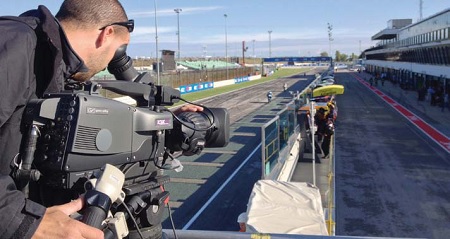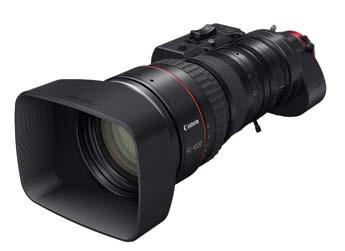4K Lens Development Limited by Physics

Grass Valley LDX 4K cameras were recently used to shoot live coverage of a MotoGP race in italy during IBC in September.
SEATTLE—Large venue live sports production promises to be a huge market for 4K production equipment in what could be the very near future. And while there are 4K cameras aplenty, switchers that can be upgraded and a host of other 4K equipment ready to go, there’s no long focal-range, highly telephoto 4K lenses to mate with the Super 35 single-sensor cameras.
The motto of high quality lens makers might as well be: “Physics will fight you.”
“When we talk about a 100x1 zoom, and the 35mm sensor, 4K, we’re talking about something we don’t think is very practical today,” said Larry Thorpe, national marketing executive at Canon USA Inc. “Once you jump from 2/3-inch imagers up to something like a Super 35, you set a baseline in element sizes, so the lens by definition is going to be larger.”
Thom Calabro director of marketing for Fujifilm Optical Devices Division, echoed that assessment. “The problem with PL is getting the sizes of the lenses to be a manageable size, something we’re used to.” Asked if it might take the form factor of a gun in a tank turret, Calabro joked: “It might be closer to a main gun on the Bismarck.”
SPACE, MECHNICAL LIMITATIONS
But really, why would such a lens be unwieldy?
A good place to start is to examine how much the focal length requirements change when going from a 2/3-inch lens (commonly referred to by its B4 lens mount), and a Super 35 sensor lens (referred to by its PL lens mount).
Get the TV Tech Newsletter
The professional video industry's #1 source for news, trends and product and tech information. Sign up below.
Taking the Canon XJ95x8.6B lens for 2/3 inch sensors as an example, its 95x zoom range is 8.6 to 820mm, with a horizontal field of view at full telephoto of just 0.67 degree. A lens providing that same zoom range and same full telephoto field of view, but for a Super 35 imager, would require a zoom range of 22 to 2,100mm. That requires bigger glass elements.
It’s not just the glass itself that takes up space, but the optomechanical design of the mechanisms that move those large lens groups while zooming and focusing.
Size and weight aren’t the only issues with the practicality of PL-mount long telephoto lenses for live sports production. Increasing the focal length of a lens reduces its depth of field. For the cine-look that’s very much in vogue with the film community, shallow depth of field is a desirable trait. For the outside broadcast cameraman high up in the stadium rafters—whose job it is to keep unpredictable action in crisp focus—shallow depth of field is a killer.
Perhaps the longest practical telephoto zoom is Canon’s new 4K Cine-Servo 50-1000mm T5.0-8.9 Ultra-Telephoto Zoom Lens. It will provide documentary and nature shooters a terrific lens for their Super 35 single sensor cameras. But it is still far short of a 95x1 lens that zooms to over 2000mm focal length.

Last month, Canon introduced the CINE-SERVO 0mm-1000mm T5.0-8.9 Ultra-Telephoto Zoom Lens, which it says is the world’s longest ultra telephoto zoom lens for 4K large-format single-sensor cameras. There’s a crossover solution that some have tried. It involves using an expansion lens between a B4 mount 2/3 inch lens and a PL-mount Super 35 sensor camera. The expansion lens expands the image size to fill the Super 35 sensor. The advantage of this setup is that the lens stays the same size but delivers the same zoom range and telephoto performance as on a B4 mount camera. The depth of field remains the same as when the 2/3 inch lens is used on a 2/3 inch camera.
Disadvantages are that any such adapter device is going to degrade the image somewhat, and there’s a couple of f/stop prices to be paid in terms of sensitivity.
A 2/3-INCH SOLUTION
“I think for sports applications everybody’s looking for a 2/3-inch solution,” said Calabro.
Luckily for those who follow that 2/3- inch 4K imager path, some camera makers have begun showing such 2/3-inch imager 4K cameras. Grass Valley had one at the 2014 NAB Show, while at IBC in September, Hitachi Kokusai demo-ed its own 2/3-inch imager 4K camera. And though they didn’t trumpet it, Panasonic displayed what it called an “engineering sample” of a single 2/3-inch sensor 4K camera.
Other camera makers are rumored to be developing their own 2/3-inch 4K imager cameras, and it would be surprising if by the next NAB Show, there weren’t a number of new such introductions.
Making a 4K camera with 2/3-inch sensors isn’t a slam dunk. To develop 2/3-inch 4K sensors with full 4K resolution will require fitting more photo-diodes on the imaging chip. To fit more on the chip will in turn require reducing the size of the photo-diodes themselves. Barring a technical breakthrough of some sort, reducing photo-diode size would reduce the camera’s sensitivity and dynamic range.
Short of developing those full-4K 2/3-inch sensors, camera makers can use schemes similar to the Bayer pattern interpolation that almost all 4K PL-mount cameras use.
Both Canon and Fujifilm point out that their top-of-the-line large 2/3-inch zoom lenses are capable of 4K resolution or close to it, and were impressed at how their lenses performed on the 4K cameras at IBC. But they’re only now getting a look at what the lenses look like on 4K cameras.
Calabro said that as 4K sports production takes hold, “in the long run I think we’re going to have to be developing 2/3- inch lenses that are specifically for 4K.”
